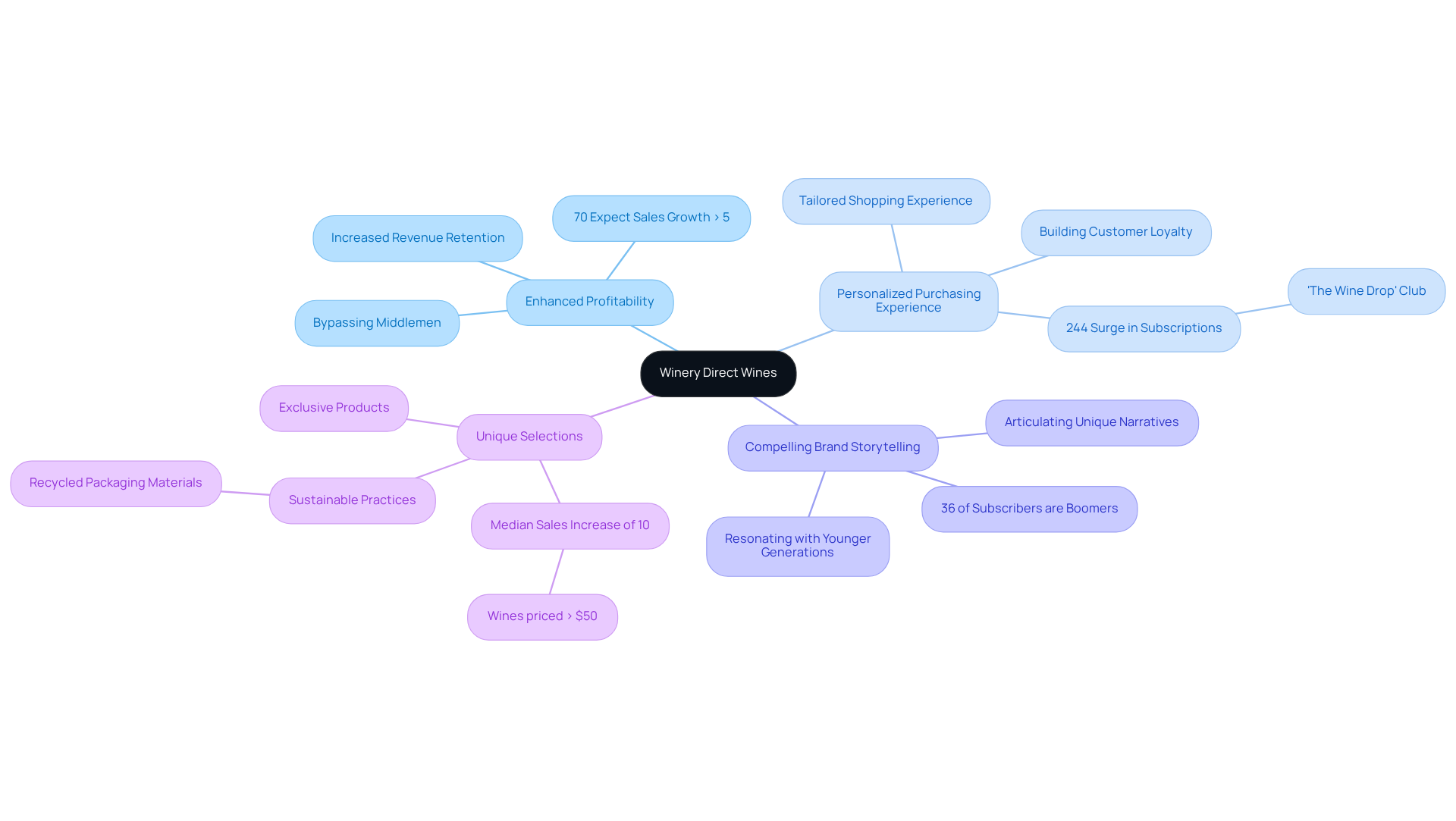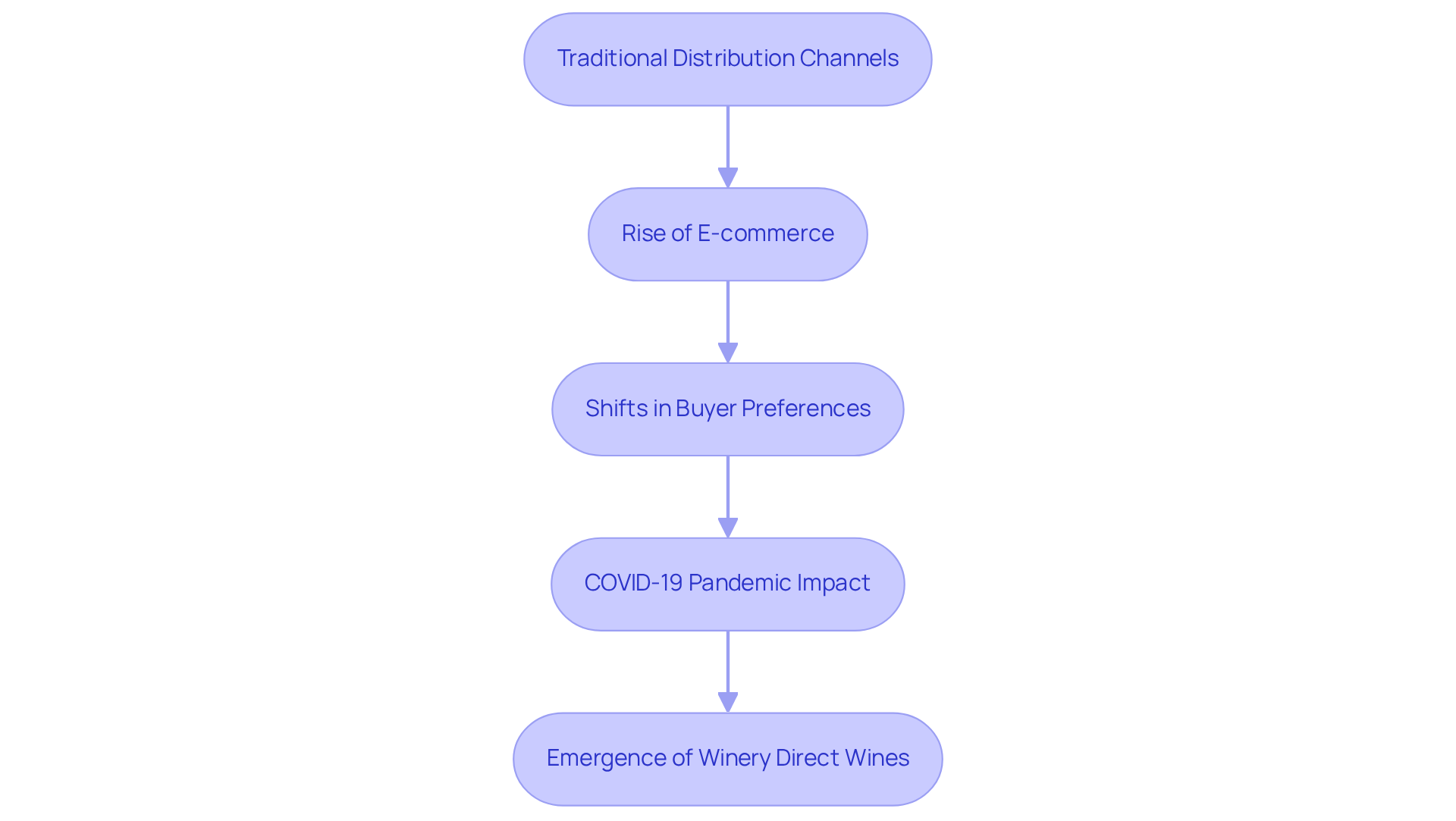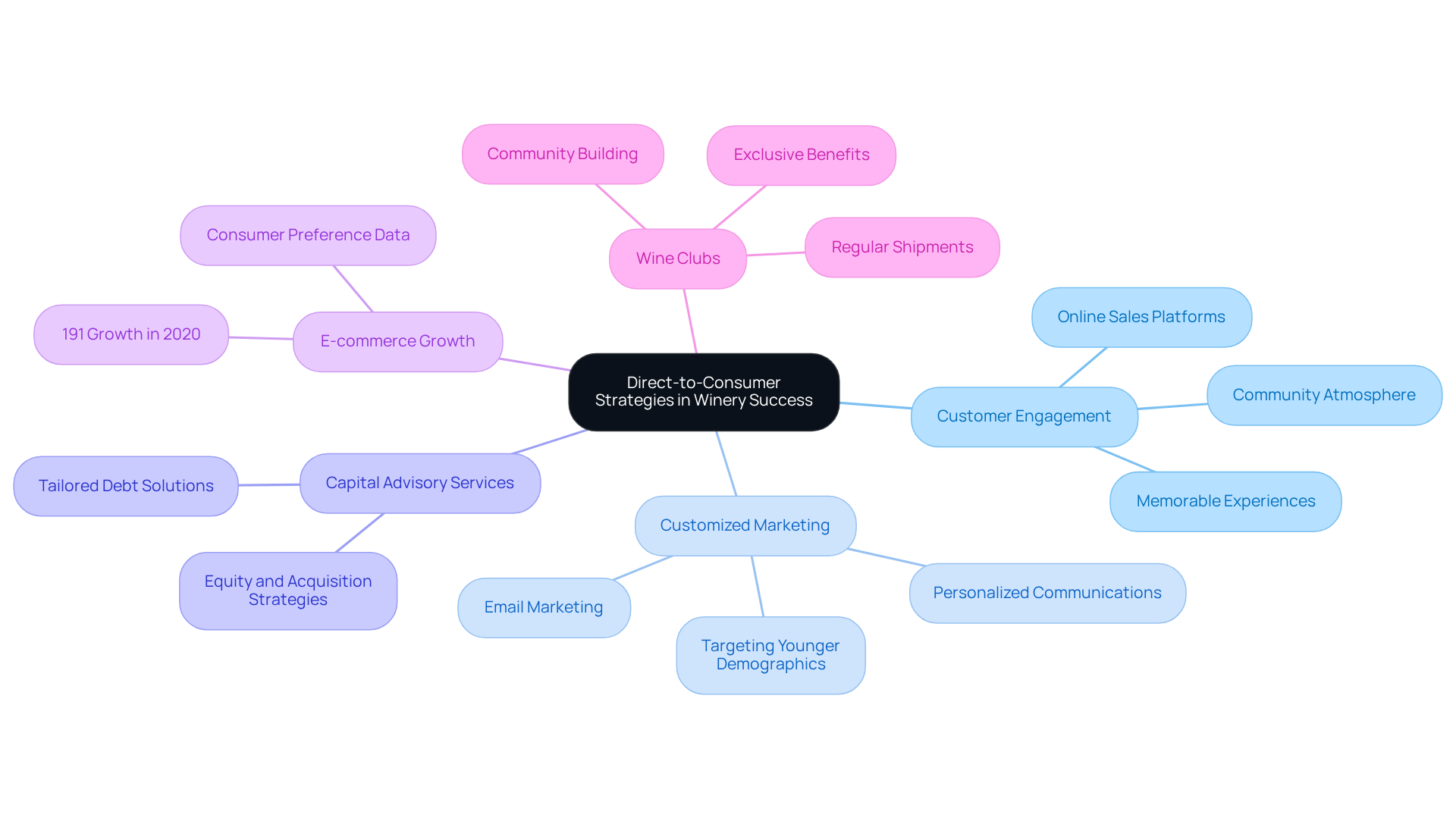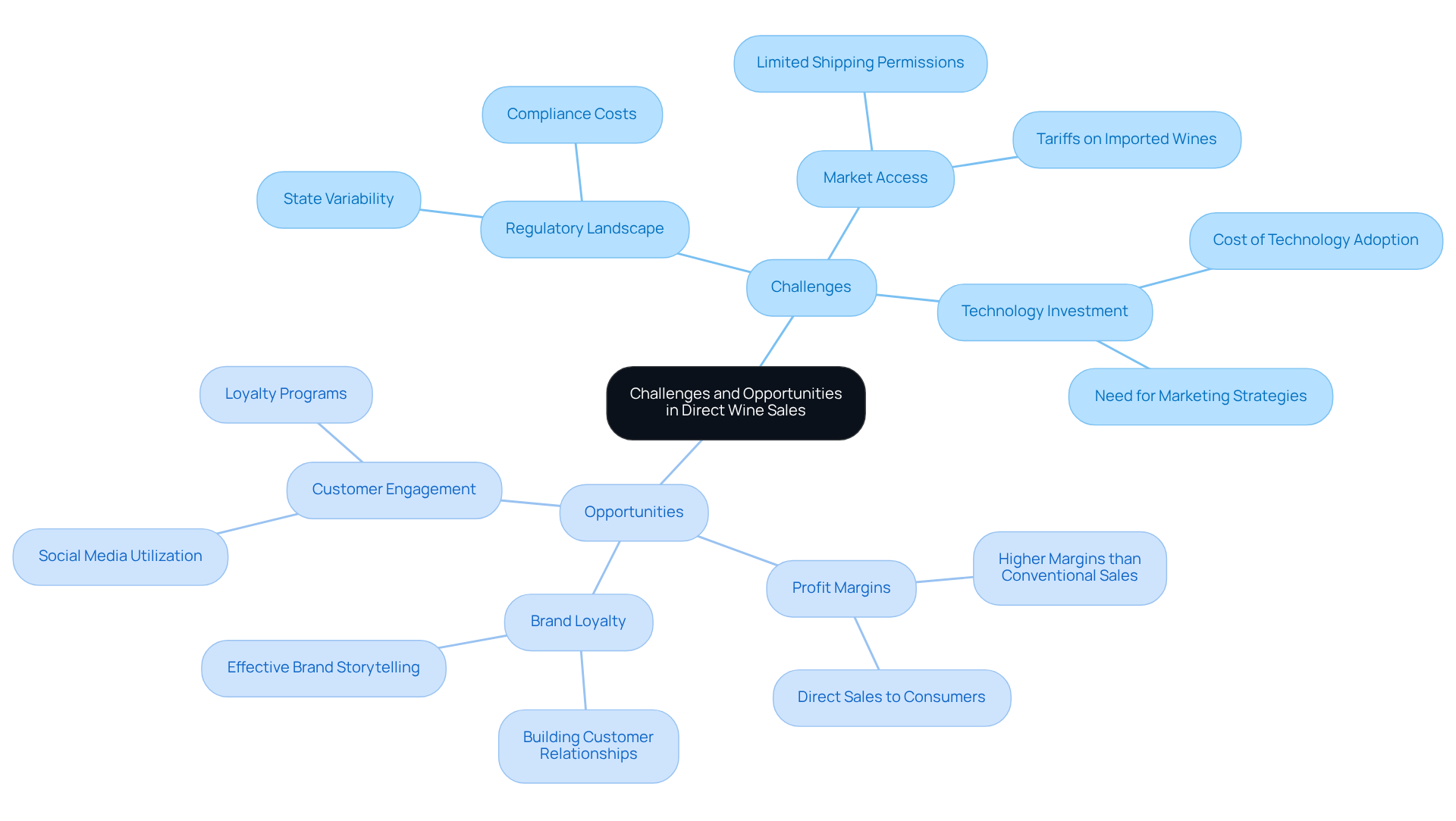Overview
Winery direct wines represent a pivotal shift in the wine industry, allowing vineyards to sell their products directly to consumers. This model not only bypasses intermediaries but also significantly enhances profitability and fosters stronger customer relationships. By adopting this approach, producers can increase their revenue while offering consumers personalized experiences and exclusive selections. Such offerings cultivate brand loyalty and underscore the critical importance of direct-to-consumer strategies in the evolving wine market. As the industry continues to adapt, embracing this model is essential for wineries aiming to thrive and connect meaningfully with their clientele.
Introduction
The wine industry is experiencing a profound transformation as vineyards increasingly adopt direct-to-consumer (DTC) sales. This shift allows wineries to connect with customers in unprecedented ways. Not only does this model enhance profitability by eliminating intermediaries, but it also cultivates a personalized purchasing experience that fosters consumer loyalty.
However, as wineries navigate this evolving landscape, they encounter challenges, including regulatory hurdles and the necessity for effective marketing strategies.
What implications does this hold for the future of winery direct wines? How can producers leverage these insights to thrive in a competitive market?
Define Winery Direct Wines: Key Characteristics and Concepts
Direct products from the vineyard represent items sold directly from the producer to consumers, effectively eliminating intermediaries such as distributors and retailers. This model empowers vineyards to exercise greater control over pricing, branding, and customer relationships. Key characteristics of winery direct wines include:
- Enhanced Profitability: By bypassing middlemen, wineries retain a larger share of the revenue, significantly boosting their bottom line. Nearly 70% of vineyards anticipate sales growth exceeding 5% in the next five years, reflecting optimism in direct-to-consumer (DTC) sales as a pivotal factor in this growth. Enocap's transformative DTC strategies, encompassing targeted marketing and personalized customer engagement, can assist family-owned vineyards in establishing sustainable channels that foster consistent growth and predictable revenue.
- Personalized Purchasing Experience: Consumers benefit from a more tailored shopping experience, allowing them to engage directly with the brand. This connection cultivates loyalty and encourages repeat purchases, as evidenced by the 244% surge in subscriptions to flexible beverage clubs like 'The Wine Drop', catering to younger consumers seeking convenience and value. Enocap's strategies aim to enhance this experience, transforming casual buyers into devoted club members.
- Compelling Brand Storytelling: Direct sales enable vineyards to articulate and share their unique narratives, resonating with customers on a personal level. This storytelling is vital in a market where younger generations, including Millennials and Gen Z, are gaining purchasing power yet often display less brand loyalty. Enocap emphasizes the importance of brand storytelling in fortifying customer relationships, crucial for maintaining a diverse demographic landscape, including the 36% of club subscribers who are boomers.
- Unique Selections: Wineries can present exclusive products that may not be accessible through traditional retail channels, enhancing their allure. For instance, vineyards with an average price exceeding $50 have witnessed a median sales increase of 10%, indicating that buyers are inclined to invest in quality when they perceive a direct connection to the source. Additionally, sustainable practices, such as utilizing recycled materials for packaging, are increasingly significant to consumers, which adds another layer of appeal to what are winery direct wines.
In summary, the direct-to-consumer model not only strengthens the connection between producers and their customers but also markedly impacts profitability. By leveraging Enocap's strategic capital planning and DTC strategies, family-owned vineyards can pursue sustainable growth and enhanced customer loyalty.

Explore the Evolution of Winery Direct Wines in the Market
The evolution of direct wines from vineyards has profoundly transformed the landscape of the wine industry in recent decades. Traditionally, vineyards depended on conventional distribution channels, which often constrained their market reach and profitability. However, the rise of e-commerce and a shift in buyer preferences towards personalized experiences have led many vineyards to consider what are winery direct wines and adopt direct-to-customer (DTC) sales. This transition was significantly accelerated by the COVID-19 pandemic, which forced producers to pivot swiftly to online sales and virtual tastings.
Consequently, what are winery direct wines have emerged as a vibrant segment of the market, with consumers increasingly enthusiastic about engaging directly with producers and supporting family-owned vineyards. This trend underscores a broader shift towards transparency and authenticity in purchasing decisions, exemplified by the 3.2% increase in DTC beverage dollar sales in 2024, despite the challenges posed by the pandemic.
Moreover, smaller vineyards have thrived in this environment, leveraging their local clientele to reduce shipping costs and enhance customer loyalty through unique offerings, such as wine-club memberships. The strategies adopted by vineyards, particularly in regions like Sonoma County and Virginia, demonstrate the effectiveness of involving consumers through personalized experiences, further solidifying the importance of DTC sales in the contemporary wine market.

Understand the Role of Direct-to-Consumer Strategies in Winery Success
Direct-to-consumer strategies are essential for the success of vineyards, especially in light of the current challenges facing the industry, such as decreased visitation and tightening sales. By optimizing online sales platforms, vineyards can significantly enhance customer engagement and cultivate lasting relationships.
Notably, vineyards that focus on customized marketing strategies have seen remarkable improvements in customer retention and loyalty, as personalized communications resonate more deeply with clients. Enocap's strategic capital advisory services empower family-owned vineyards to unlock growth opportunities through tailored debt, equity, and acquisition solutions, thereby amplifying their DTC initiatives.
In fact, Enocap's clients experienced an impressive average e-commerce growth of 191% in 2020, highlighting the effectiveness of DTC strategies. Furthermore, DTC sales channels provide producers with invaluable data on consumer preferences, enabling them to refine their product offerings and marketing strategies effectively.
Wine clubs play a pivotal role in fostering a community of loyal customers who feel a personal connection to the brand, offering regular shipments and exclusive benefits that enhance loyalty. As the beverage sector continues to evolve, embracing these transformative DTC strategies and capital advisory services will be crucial for producers aiming to secure their market position.

Analyze Challenges and Opportunities in Direct Wine Sales
The direct-to-consumer (DTC) model presents producers with a wealth of opportunities, yet it is accompanied by significant challenges. One of the primary hurdles is the intricate regulatory landscape governing beverage shipping, which varies by state and can restrict market access. For instance, while 47 states and D.C. permit DTC wine shipping, states like Delaware, Mississippi, and Utah still lack permissions, complicating expansion efforts for wineries. Moreover, smaller producers frequently encounter obstacles in investing in the essential technology and marketing strategies to effectively connect with buyers online.
Despite these challenges, the potential rewards are considerable. Wineries that effectively implement DTC strategies can achieve profit margins that are significantly greater than conventional sales channels, alongside improved brand loyalty and the opportunity to share their distinctive stories directly with buyers. Enocap specializes in transforming casual buyers into loyal club members through proven strategies that include effective brand storytelling and customer engagement. For instance, establishments leveraging social media to enhance customer engagement have reported significant increases in sales and brand awareness.
Furthermore, case studies demonstrate the beneficial effects of DTC laws; the recent legislation in Mississippi, for example, permits licensed producers to ship directly to consumers, broadening their market access and improving consumer choice. As vineyards navigate these complexities, understanding both the challenges and opportunities will be crucial for positioning themselves for success in an increasingly competitive market. Industry leaders stress the significance of technology investments, declaring that adopting contemporary tools is crucial for businesses to succeed in the DTC environment. Enocap's strategic capital planning can also assist wineries in identifying debt, equity, or acquisition opportunities, further enhancing their growth potential.

Conclusion
The emergence of winery direct wines fundamentally reshapes the relationship between producers and consumers, fostering a more intimate and profitable connection. By eliminating intermediaries, wineries enhance their profitability, engage customers on a personal level, and share their unique narratives. This direct-to-consumer model not only allows for greater control over branding and pricing but also cultivates a loyal customer base eager for exclusive products and experiences.
Insights reveal that the evolution of winery direct wines has been propelled by shifting consumer preferences towards personalized purchasing experiences, particularly in the wake of the COVID-19 pandemic. The rise of e-commerce and innovative DTC strategies have enabled vineyards to thrive, despite challenges such as regulatory hurdles and market competition. By emphasizing tailored marketing and community-building initiatives, wineries can transform casual buyers into devoted supporters, thereby enhancing both retention and sales.
As the wine industry continues to evolve, embracing the opportunities presented by direct sales is vital for success. Wineries must navigate the complexities of regulations while investing in technology and marketing strategies that resonate with today’s consumers. By focusing on building genuine connections and leveraging the strengths of direct-to-consumer approaches, vineyards can secure their place in a competitive market, ensuring sustainable growth and a loyal clientele.
Frequently Asked Questions
What are winery direct wines?
Winery direct wines are products sold directly from the vineyard to consumers, eliminating intermediaries like distributors and retailers. This model allows wineries to have greater control over pricing, branding, and customer relationships.
What are the key characteristics of winery direct wines?
Key characteristics include enhanced profitability, personalized purchasing experiences, compelling brand storytelling, and unique selections of wines that may not be available through traditional retail channels.
How does the direct-to-consumer model affect winery profitability?
By bypassing middlemen, wineries retain a larger share of the revenue, which significantly boosts their bottom line. Nearly 70% of vineyards expect sales growth exceeding 5% in the next five years due to the direct-to-consumer sales model.
What benefits do consumers receive from purchasing winery direct wines?
Consumers enjoy a more tailored shopping experience, allowing for direct engagement with the brand, which fosters loyalty and encourages repeat purchases.
How important is brand storytelling in winery direct sales?
Brand storytelling is vital as it helps vineyards share their unique narratives, resonating with customers personally. This is especially important for younger generations, who often have less brand loyalty but are gaining purchasing power.
What unique offerings do wineries provide through direct sales?
Wineries can offer exclusive products not typically found in traditional retail channels, enhancing their appeal. For example, vineyards with higher average prices have seen increased sales, indicating that consumers are willing to invest in quality when they feel a direct connection to the source.
How do sustainable practices play a role in winery direct wines?
Sustainable practices, such as using recycled materials for packaging, are increasingly important to consumers and add to the appeal of winery direct wines.
How can wineries leverage strategies for sustainable growth?
By utilizing strategic capital planning and direct-to-consumer strategies, family-owned vineyards can pursue sustainable growth and enhance customer loyalty.




